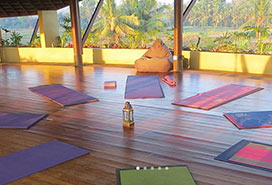People come to my meditation classes hoping to find peace and calm. Sometimes the first thing they notice is how not peaceful and calm they are! Perhaps even long ignored or buried emotions like fear and anger surface, and they run from their meditation practice shouting, “I thought this would be fun!”
So what is meditation? Is it blissful sitting and finding our center? Or is it hard work, using effort to struggle through our patterns? Perhaps both.
It takes courage and effort to break patterns, see our stuff, face our feelings. It takes some practice and techniques and teachings to learn how to prepare the body, sit still, and calm the mind to some degree. This is the yang or masculine side of the practice. One cannot do yoga without getting on the mat. One cannot meditate without sitting down and finding a way to move beyond thinking and doing.
We can use whatever “techniques” or effort we can to do this. Conscious regulation of the breath (called pranayama in yoga terms) is one of my favorite ways to still the mind. We can simply follow the breath or deepen the breath, and the breath often leads us deeper into our meditation.
Some of us like to use a mantra, such as “I am love.” This is an excellent way to still the mind and move out of the thinking and planning. We can also feel our feelings. Bring our attention down from our thinking mind and down into the body and just feel what is going on.
Ultimately though, our meditation practice is more being than doing, more allowing than controlling, observing than changing. Our world has had the masculine do-orientation turned up for eons, and it is time to move more into the feminine effortlessness of being. This is more about heart than head, feeling rather than thinking. This is where we need to focus not only on our meditation cushion and yoga mat, but in our world.
Again, use whatever technique to get there, but know you are already always “there.” Truth is here, now. We are not trying to get anywhere. We follow the Tao (truth), the divine flow, moving with rather than against the currents. We don’t change but observe thoughts. We don’t control or plan where we are going. We don’t fight against life but let it teach us–and it always will.
Meditation is more about being, essence, and presence. We are coming out of such a painful time on planet earth. We are afraid, our energy systems are on high alert, we see enemies everywhere, and our self esteem is so low we feel we need to earn a date with the Divine. But the Divine, or Truth, or God, or Joy, or the Sacred–choose your word–is always closer than close. And grace is always pouring in, if we can only learn to let go and receive it.
I use the words, “drop in,” when I finish my breath, prayer, and gratitude parts of my meditation. This reminds me that the “effort” part of the meditation is over. It does not mean that I try to change or eliminate thoughts, but I watch and let go of control. Then I sometimes drop in to a sacred space, a rare moment in my day when my mind is still. This provides a baseline, a reminder that we do not have to live in the maniacal mind and the false, egotistical self. As Neale Donald Walsch says, “You have to be out of your mind to find God.”
When we find ourselves in that place of stillness, the breath becomes automatic, the impermanent aspects of ourselves like personality, titles, names, and concepts fall away, leaving the energetic essence of being. As Rumi says, “Give up your drop and become part of the ocean.” We let go of that delusion of separation, we trust, and at long last, we feel the effortless joy of our divine self, connected to all that is.
This is where we come from. This is where we return to. It is inevitable. Meditation is hard work. And it is simple. Do not think too much about it. Let effortless effort guide the way, knowing there is nowhere to go, nothing to do.


Recent Comments